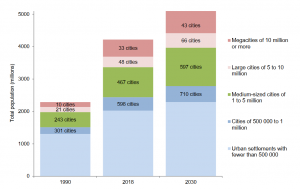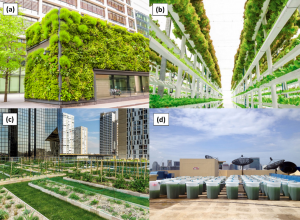Robert Axelrod
The migration of people from rural to urban areas and a growing world population result in many challenging problems and affect numerous systems; one of which is the food system. Growing and expanding cities potentially use up arable land, shift people’s demands towards processed and convenience food, require intensified distribution channels, and impede closing life cycles. Engaging metropolitan areas in urban agricultural activities has a huge potential to solve numerous of the aforementioned challenges.
Major trends and challenges
Urban areas are becoming more and more populated at a rate of 1.5% – a trend that is not expected to change in the near future.1,2 In 2018, 55% of the world’s population (around 4.2 billion people) lived in cities, towns, conurbations, or suburban areas. This number is projected to increase to 68% by 2050.1,2 Many challenges, such as ensuring safe and affordable housing, providing affordable and sustainable transport systems, protecting urbanized regions from natural disasters, reducing the environmental impact of urban areas, and providing sufficient and sustainable food, arise.3 The ever-growing global population, projected to reach 9.8 billion by 2050, further increases the problematic situation of providing enough food at a high quality, while simultaneously impacting the environment as little as possible.4

Figure 76.1 – Population and number of cities of the world, by size class of urban settlement: 1990, 2018 and 2030. (Source: UN World Urbanization Prospects 2018)
Why are people moving to urban areas?
Urban centers are a concentration of political power, knowledge (universities), wealth, jobs, and cultural exchange. Initially, urban growth resulted from the industrialization. In these industrialized hubs, wealth and power were accumulated through productivity gains, accelerating the migration of workers in search of better economic opportunities.5 In summary, reasons for the observed urbanization trends can be classified as push- and pull-factors. The former include poverty, reduction of workplaces in the agricultural sector, and lack of educational institutions; the latter include job opportunities, access to better infrastructure, such as hospitals, transportation, and technologies.
Negative impacts on the food system5,6,7
Of the many impacts urbanization has (e.g., air pollution, water quality, diseases, inequality), the effect on the food system shall be highlighted in the following.
First, urban centers that grow and expand require land to construct buildings (office buildings, apartments, hospitals, schools) and build streets on. This land is very likely fertile, since urban areas historically grew and developed in arable areas. Examples where this has already happened are China, India, Turkey, USA, and Vietnam. In other words, the way things are, building new safe and affordable housing might directly compete irreversibly with food production capacities. Cropland loss is predicted to be severe in parts of the world, where urban population growth rates are high and the agricultural sector is the most dominant.
Second, urbanization has led to food and nutritional insecurity for people living in poverty. Having left rural areas in the hope of seizing more favorable opportunities in urban areas, but not being able to accomplish this, people find themselves living in a situation, where they barely own any money and have no arable land to achieve food self-sufficiency.
Third, the demand shifts from local, organic, home-prepared food to processed, pre-prepared food. People that were able to use the economic opportunities in their favor tend to work longer hours and have the money to purchase convenience food. This kind of food tends to have a higher salt, fat, and sugar content – all attributes that makes it tastier, yet unhealthier. The increased risk of death ensued an awareness for health, which resulted in societal trends – opposite from the one described above – demanding healthier and locally grown food.
Fourth, an increased urban population requires an improved food distribution channel from the rural area, where the calories are grown, to the urban area, where they are consumed. In order to guarantee food safety, packaging and cooling infrastructure is needed. An intensified transportation and distribution causes additional greenhouse gas emissions, amplifying the ecological footprint.
Fifth, some of the calories that are brought to urban centers lead to waste on the consumer side. This waste could lead to an increased ecological footprint if biomass life cycles are not closed appropriately (biorefineries, bringing nutrients back to rural areas).
Urban farming as a solution
One way to address the above-mentioned impacts is to grow food in the urban environments themselves. Up until now, community gardens are the most dominant form of urban agriculture. More innovative forms, such as rooftop gardens, rooftop greenhouses, indoor farms, vertical farms (hydroponics, aeroponics, aquaponics), or edible green walls, have yet to be widely implemented, used on a large scale, and commercialized.8,9 The more innovative approaches would transform buildings into “arable land”. Various (potential) benefits have been identified that directly counteract the negative impacts described above:9
- Social benefits: reduced crime, gathering places, learning opportunities on how food grows.
- Environmental benefits: increased biodiversity, reduced air pollution, less greenhouse gases, carbon sequestration.
- Health and food security benefits: organic food, less expensive, more fruit and vegetable consumption.
- Economic development benefits: more start-ups and jobs in the city, increased property value.
Furthermore, food is being produced, where it is consumed, facilitating the re-closure of biomass cycles. Areas of urban farming, such as vertical farms in hydro-/aero-/aquaponics or indoor farms, have the potential to optimize resource consumption for the food production by micromanaging nutrient allocation. Additionally, these production sites seem to be little or not dependent on chemical pesticides.5

Figure 76.2 – Examples of urban farming: (a) edible green wall, (b) vertical farming, (c) rooftop farming of crops, (d) rooftop farming of algae. (Image sources a-d: see below)
Concluding remarks
The concentration of knowledge and innovation in urban areas can greatly counter-balance the negative impacts that urbanization has and will continue to have on the food system. The future and success of sustainable cities will rely on an integration of innovative agricultural approaches, since continuing urbanization trends seem to be inevitable.
References
1. United Nations (2018), Department of Economic and Social Affairs
https://www.un.org/development/desa/en/news/population/2018-revision-of-world-urbanization-prospects.html, Last access: 23.04.2020
2. European Commission (2018), “Worldwide urban population growth”
https://ec.europa.eu/knowledge4policy/foresight/topic/continuing-urbanisation/worldwide-urban-population-growth_en, Last access: 23.04.2020
3. The Global Goals (2020), “Sustainable Cities and Communities”
https://www.globalgoals.org/11-sustainable-cities-and-communities, Last access: 23.04.2020
4. United Nations (2017), Department of Economic and Social Affairs
https://www.un.org/development/desa/en/news/population/world-population-prospects-2017.html, Last access: 23.04.2020
5. Designing Urban Food policies “Urbanization Issues Affecting Food System Sustainability”
https://link.springer.com/chapter/10.1007/978-3-030-13958-2_1, Last access: 23.04.2020
6. Nutrition and Food Science Technology, “Food for an Urban Planet – Challenges and Research Opportunities”, D. Knorr, C.S.H. Khoo, M.A. Augustin
https://www.frontiersin.org/articles/10.3389/fnut.2017.00073/full, Last access: 23.04.2020
7. Science (2016), “Hidden linkages between urbanization and food systems”
https://science.sciencemag.org/content/352/6288/943, Last access: 24.04.2020
8. USDA, Urban Agriculture (2020), “Urban Agriculture”
https://www.nal.usda.gov/afsic/urban-agriculture, Last access: 24.04.2020
9. Johns Hopkins Center for a Livable Future (2016), “Vacant lots to vibrant plots: A review of the benefits and limitations of urban agriculture“ https://www.researchgate.net/publication/319213554_Vacant_lots_to_vibrant_plots_A_review_of_the_benefits_and_limitations_of_urban_agriculture, Last access: 24.04.2020
Image source:
(a) https://www.organeco.ltd/s/cc_images/cache_2481959787.jpg, Last access 24.04.2020
(b) https://logisticsviewpoints.com/2020/01/29/vertical-farming/, Last access 24.04.2020
(c) https://www.zinco-arabia.com/systeme/urban-farming.html, Last access 24.04.2020
(d) http://algaetrends.com/2014/02/rooftop-farming/, Last access 24.04.2020
Media Attributions
- Urbanization trends © UN
- Urban farming